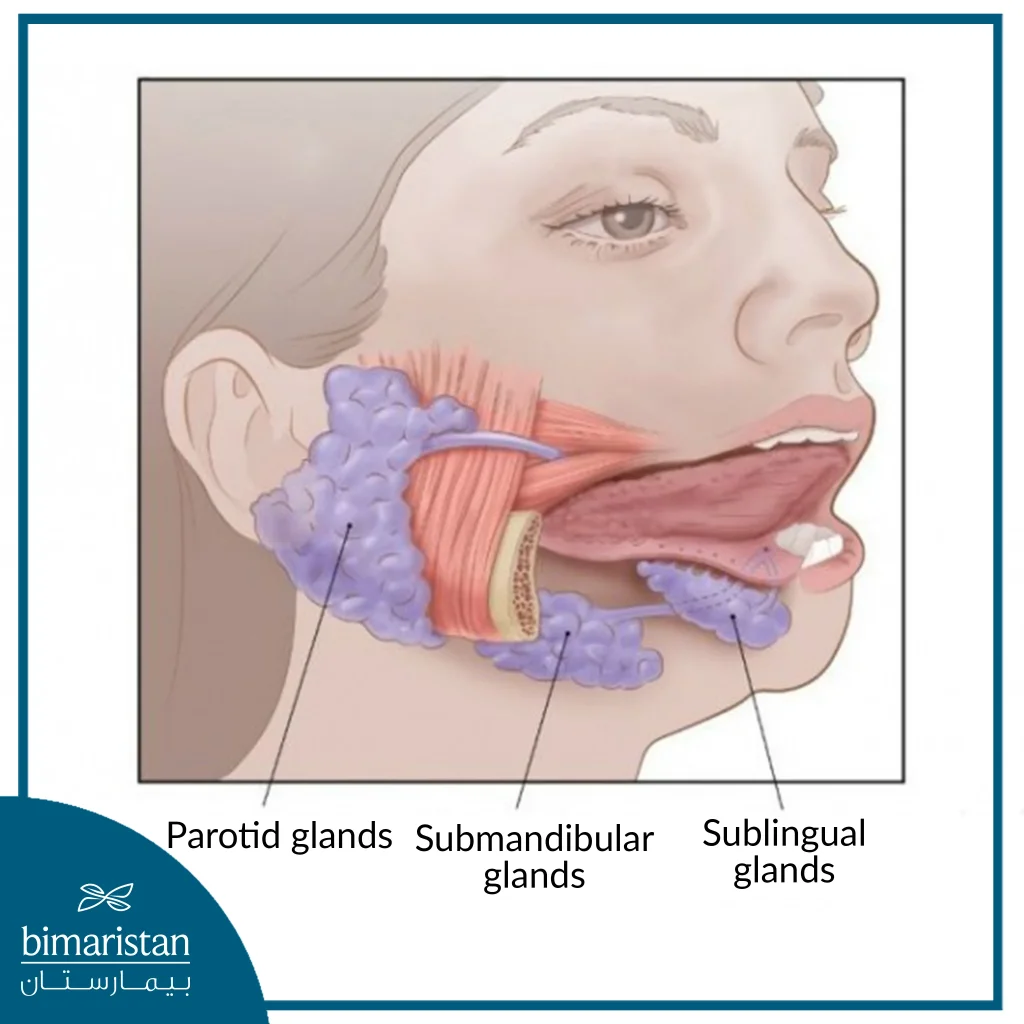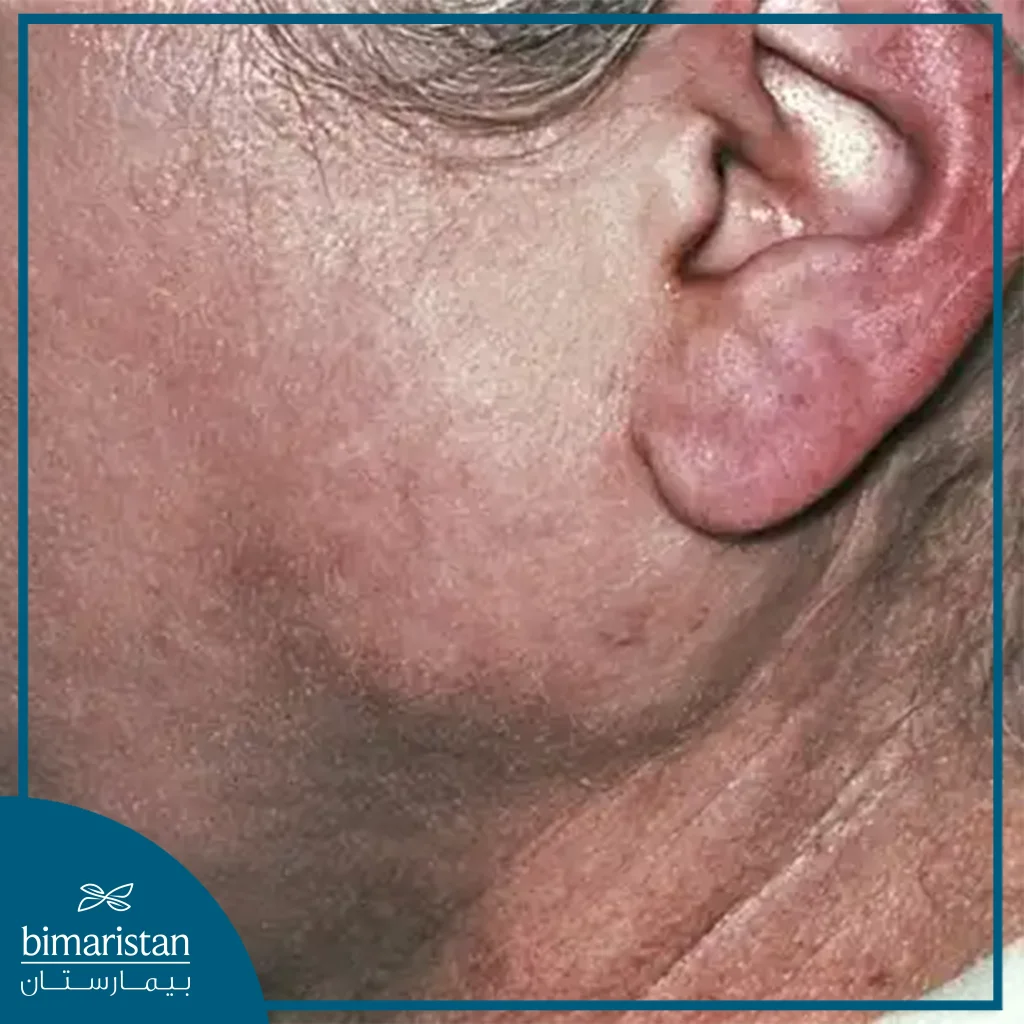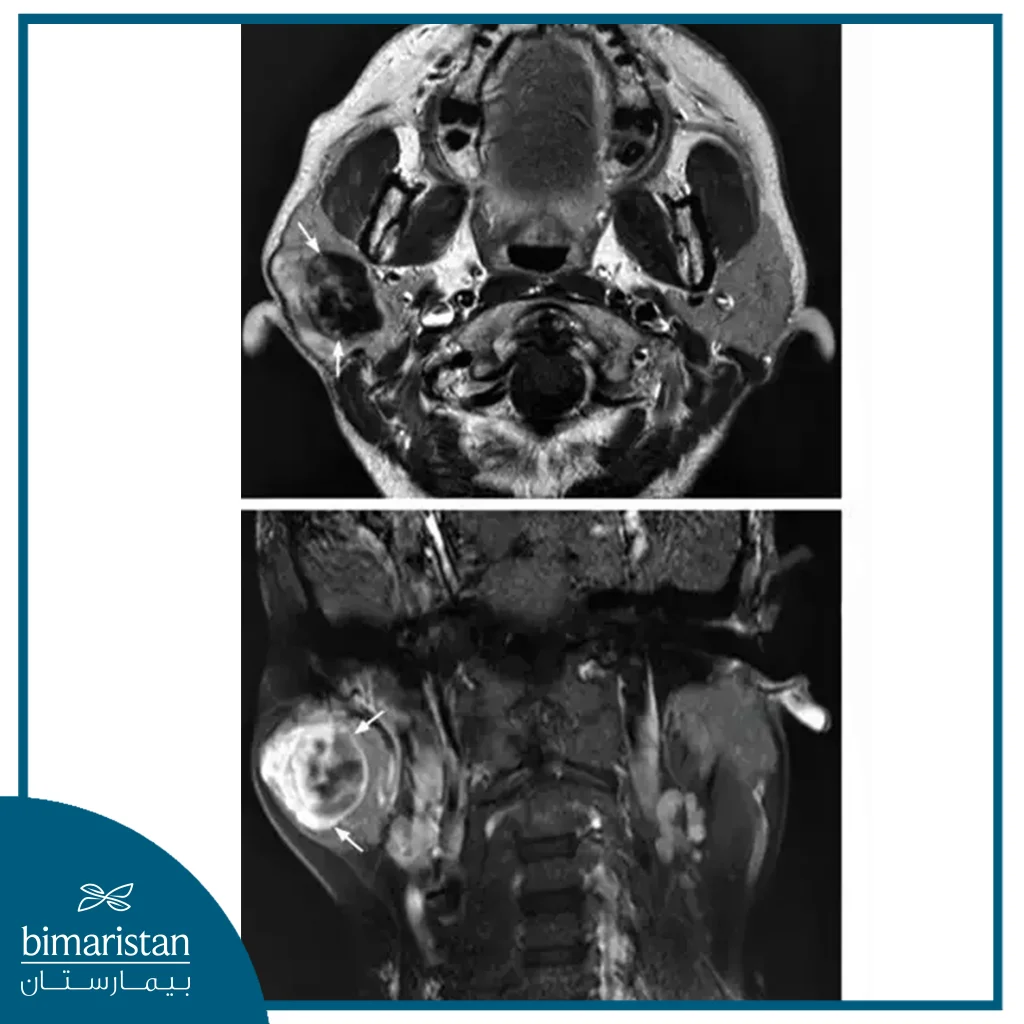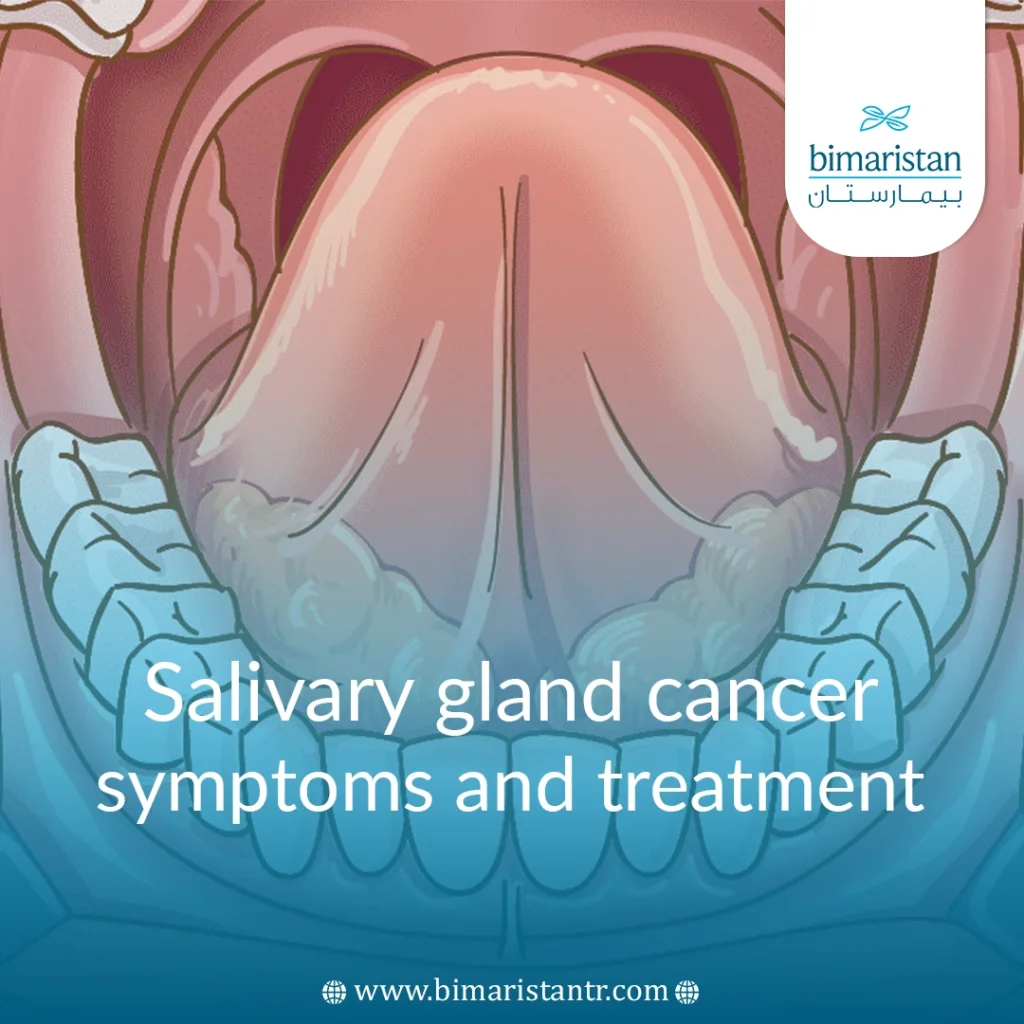Salivary gland cancer affects the glands responsible for secreting saliva in the mouth area. In this section, you will learn about the modern techniques available to treat salivary gland cancer in Turkey.
There are two types of tumors, malignant (cancerous) and benign (noncancerous), which occur in equal numbers.
The chance of a cure depends on where the cancer is located in the salivary glands, whether it is in the area where it started or has spread to other tissues, how the cancer cells look under a microscope, and the patient’s general health.
What are the salivary glands?
They are the glands responsible for producing saliva and releasing it into the mouth to keep the mouth and throat moist. They also help swallow and digest food.
These glands vary in size, as there are large and small salivary glands. There are three pairs of major salivary glands: the parotid gland, the submandibular glands, and the sublingual glands.

Parotid gland
The parotid glands are located in front of the ears and behind the jaw. Saliva is secreted into the mouth through a tube called the parotid duct. This tube opens from the inside on the cheek near the area of the upper molars.
The facial nerve passes through the parotid gland and controls the facial muscles. It is the nerve responsible for making you smile, frown, close your eyes, and raise your eyebrows.
The parotid gland is the largest salivary gland and is where most salivary gland cancers occur.
The parotid glands also contain lymph nodes, which are part of the immune system’s defense against infections. Skin cancers can sometimes spread to these lymph nodes within the parotid glands, but fortunately, most parotid gland tumors are not cancers and are called benign tumors.
Submandibular and sublingual glands
The submandibular glands are located under the jawbone, one on each side. They release saliva into the mouth through a duct (tube) that opens in the floor of the mouth under the tongue.
In addition to these glands, we find three important nerves: the hypoglossal nerve, the lingual nerve, and the marginal branch of the lower jaw of the facial nerve. These nerves give the tongue movement, sensation, and taste and move the lower lip.
Submandibular gland tumors can be benign (not cancerous) or malignant (cancerous).
As the name suggests, the sublingual glands are located under the tongue, one on each side. They release saliva into the submandibular canal, which is located near the lingual nerves that give feeling and taste at the front of the tongue.
The sublingual glands are the smallest of the major salivary glands and rarely develop tumors, but when they do, they tend to be malignant (cancer) when they develop.
Minor salivary glands
There are hundreds of small salivary glands spread throughout the mouth and throat. They can be found inside the mouth just below the surface, including the lips, cheeks, and top of the mouth (soft palate). Minor salivary glands can also develop benign or malignant tumors.
What is salivary gland cancer?
Salivary gland cancer is a term used to describe malignant tumors that affect the salivary glands in or near the mouth. Salivary gland tumors may be benign (noncancerous) or malignant (cancerous), each occurring with equal frequency.
Salivary gland cancer may affect any of the salivary glands. Your prognosis (outlook) depends on the type of salivary gland cancer you have and the stage of the disease (how advanced the disease is).
Who is likely to get salivary gland cancer?
Anyone can develop salivary gland cancer, but men are more likely to develop salivary gland tumors. A person also becomes more likely to develop salivary gland cancer if:
- 55 years of age or older
- Smokes or uses alcohol frequently
- Receives radiation therapy to the head or neck or is exposed to radioactive materials
- He works in some trades, including plumbing, rubber product manufacturing, asbestos mining, and leather industries.
Symptoms and causes of salivary gland tumors
What causes salivary gland cancer?
The exact cause of most salivary gland cancers is unknown. Salivary gland tumors can occur in any salivary gland in or near the mouth. The most common of them occur in the three main salivary glands, which are:
- Parotid glands (inside each cheek)
- Submandibular glands (at the floor of the mouth)
- Sublingual glands (under the tongue)
Salivary gland cancer also occurs within the small, microscopic salivary glands. These glands are located inside the roof or floor of the mouth, the lining of the tongue and lips, and inside the cheeks, sinuses, nose, and voice box.
Salivary gland tumors may be benign or malignant (cancer). Benign tumors generally grow slowly and are unlikely to spread to other tissues.
About 50 percent of salivary gland tumors are noncancerous. However, some are malignant and may spread to other body areas.
What are the symptoms of salivary gland cancer?
A small number of people with salivary gland cancer have no symptoms. Salivary gland cancer usually causes a painless lump in the salivary glands.

If your salivary gland tumor is malignant, you are likely to experience other symptoms, including:
- Weakness or numbness in the face, neck, jaw, or mouth.
- Persistent pain in the face, neck, jaw, or mouth.
- Difficulty opening your mouth fully or moving your facial muscles.
- Difficulty swallowing.
- Bleeding from the mouth.
Diagnosis and tests
How is salivary gland cancer diagnosed?
Your doctor diagnoses salivary gland cancer through a physical examination and a review of your medical and personal history.
In some cases, doctors may order additional diagnostic tests to confirm the presence of a tumor. These tests include:
- CT scan uses X-rays to provide images of masses within the salivary glands
- MRI, which uses magnets and radio waves to create images of the body’s internal structures
- Positron emission tomography (PET) uses small amounts of radioactive material to identify cancerous masses
- Fine needle biopsy to collect a small sample of tissue and fluid from a salivary gland tumor for further examination in the laboratory

When should I contact my doctor?
If you have any symptoms of salivary gland tumor listed above, especially if symptoms persist for more than two weeks, contact your doctor for a diagnostic evaluation.
What are the stages of salivary gland cancer?
Once salivary gland cancer is detected, further tests will be done to see if the cancer cells have spread to other body parts. This is called staging. The doctor needs to know the stage of the disease to plan treatment.
Salivary gland cancers are classified by ‘grade’, which tells us how quickly the cancer cells grow and spread based on how the cells look under a microscope. Low-grade cancers grow more slowly than high-grade cancers.
The following stages are used to treat salivary gland cancer:
Stage I salivary gland cancer
The cancer is 2 cm or less in diameter and has not spread beyond the salivary glands.
Stage II salivary gland cancer
The cancer is larger than 2 cm but no more than 4 cm in diameter and has not spread beyond the salivary glands.
Stage III salivary gland cancer
- Any of the following may be true: The cancer is more than 4 cm in diameter and has spread to the skin, soft tissue, bone, or nerves around the gland. The cancer may or may not have spread to a single lymph node.
- The cancer is less than 4 cm in size and has spread to one lymph node.
Stage IV salivary gland cancer
The first fourth stage
Any of the following may be true:
Cancer has spread to the skin, soft tissues, bones, or nerves around the salivary gland and may be up to 6 centimeters in size. It may have spread to one or more lymph nodes but not to other parts of the body.
Cancer of any size has spread to nearby tissues and has spread to one lymph node on the same side of the neck as cancer and to lymph nodes on both sides of the neck or to no lymph node.
The second fourth stage
Any of the following may be true:
The cancer has spread to the bones of the skull and/or the surrounding carotid artery, which is the main (right and left) artery of the neck that carries blood to the head and brain and may have spread to one or more lymph nodes.
The cancer is larger than 6 cm and may have spread to nearby tissues and has spread to at least one lymph node.
The third fourth stage
The cancer may be of any size and may have spread to nearby tissues and lymph nodes and other parts of the body.
Recurrence and recurrence of salivary gland cancer
This means that the cancer recurs after treatment. It may return in the salivary glands or another part of the body.
Salivary gland cancer treatment
Surgery is usually the best treatment option for safely removed polyps. After surgery, your recovery focuses on preventing infection and managing pain. Your doctor may prescribe antibiotics and pain relievers to achieve these goals.
If the tumor is growing rapidly or has spread to other body parts, your doctor may recommend additional treatments. These treatments include:
Surgery
Surgery is the primary treatment for malignant salivary gland tumors. The surgeon may remove lymph nodes (lymphadenectomy) in addition to removing the tumor if the cancer is suspected to have spread there. After surgery, you will likely receive radiation therapy to kill any remaining cancer cells so that the cancer does not come back.
Radiotherapy
In radiotherapy, a device directs radiation toward a part of the body that contains cancer cells to destroy them. Two types of radiotherapy are used to treat salivary gland cancer: photon beam and neutron beam.
You may also receive radiation as part of palliative care, which provides relief from symptoms and improves your treatment experience and overall quality of life.
Chemotherapy
Chemotherapy uses medications to destroy cancer cells. You may receive chemotherapy if the cancer has spread from the salivary glands to other tissues outside the head and neck.
Follow-up after treatment
Some of the tests performed to diagnose cancer may be repeated later to determine how well the treatment is working. Based on the results of these tests, decisions are made about continuing, changing, or stopping treatment.
Some tests will continue to be done from time to time after treatment has finished. The results of these tests show whether your condition has changed or if the cancer has recurred (come back). These tests are called follow-up tests or screenings.
Sources:
